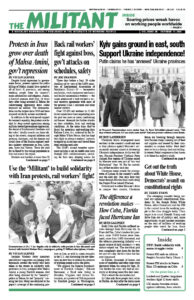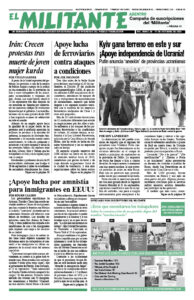Below is an excerpt from an April 2018 article on the social and political roots of protests by workers and youth that swept 90 cities and small towns across Iran. It points to an article that had appeared in the Feb. 4 New York Times about how women being forced to wear the hijab to cover up their hair was “a symbol” that “has been enforced since the 1979 Islamic Revolution.”
But the compulsory hijab — a headscarf covering the hair and neck — is not “a symbol of Iran’s revolution.” To the contrary.
Yes, most working people and youth who made the 1979 revolution opposed the royal decree imposed in the 1930s by the imperialist-backed shah of Iran, in the name of capitalist “modernization,” denying women the right to decide for themselves how to dress in public. The shah’s cops who ripped veils off women’s heads and faces were the same ones who dragged workers and youth to torture centers and prisons across Iran.
But in March 1979, when Ayatollah Ruhollah Khomeini declared that female employees of government ministries must not go to work “naked” but be “clothed according to Islamic standards,” students, workers and other women and men took to the streets by the tens of thousands across Iran — the largest International Women’s Day outpouring anywhere in the world that year. Demonstrators fought off organized thugs and forced Khomeini to back down.
What’s more, the government’s labor ministry later that month announced that women in factories and other workplaces were entitled to equal rights on the job, including the right to participate in elections to the workers councils (shoras) and to hold office.
It was not until mid-1983, as the counterrevolution consolidated its stranglehold, that the Iranian regime was finally able to impose legislation barring women from “appear[ing] in public without religious hijab.” Over the next couple of years, the government increasingly unleashed special “anti-vice” squads to confront women on the streets and compel observance.
The acts of public defiance of this law since December, as well as longer-term resistance to enforcement the regime has met in recent years, are a manifestation of mounting consciousness about and struggles against the indignities, abuse and discrimination faced by women the world over. Far from being a hobby horse of wealthy and middle-class women in Iran (as often caricatured in the bourgeois press), demands for women’s rights — in word and deed — were central to struggles by millions, including working women and men, during the 1979 revolution. They are among the revolution’s eroded conquests. Prospects for defense and advance of such gains have been renewed by the recent working-class protests and others to come.
There will be no end to Tehran’s counterrevolutionary wars, expansionism and reactionary social policies without an end to the counterrevolutionary bourgeois clerical regime. The factional divisions within the bourgeois government and ruling layers are creating greater political space for workers and farmers, who acted on these openings in late December and early January.

